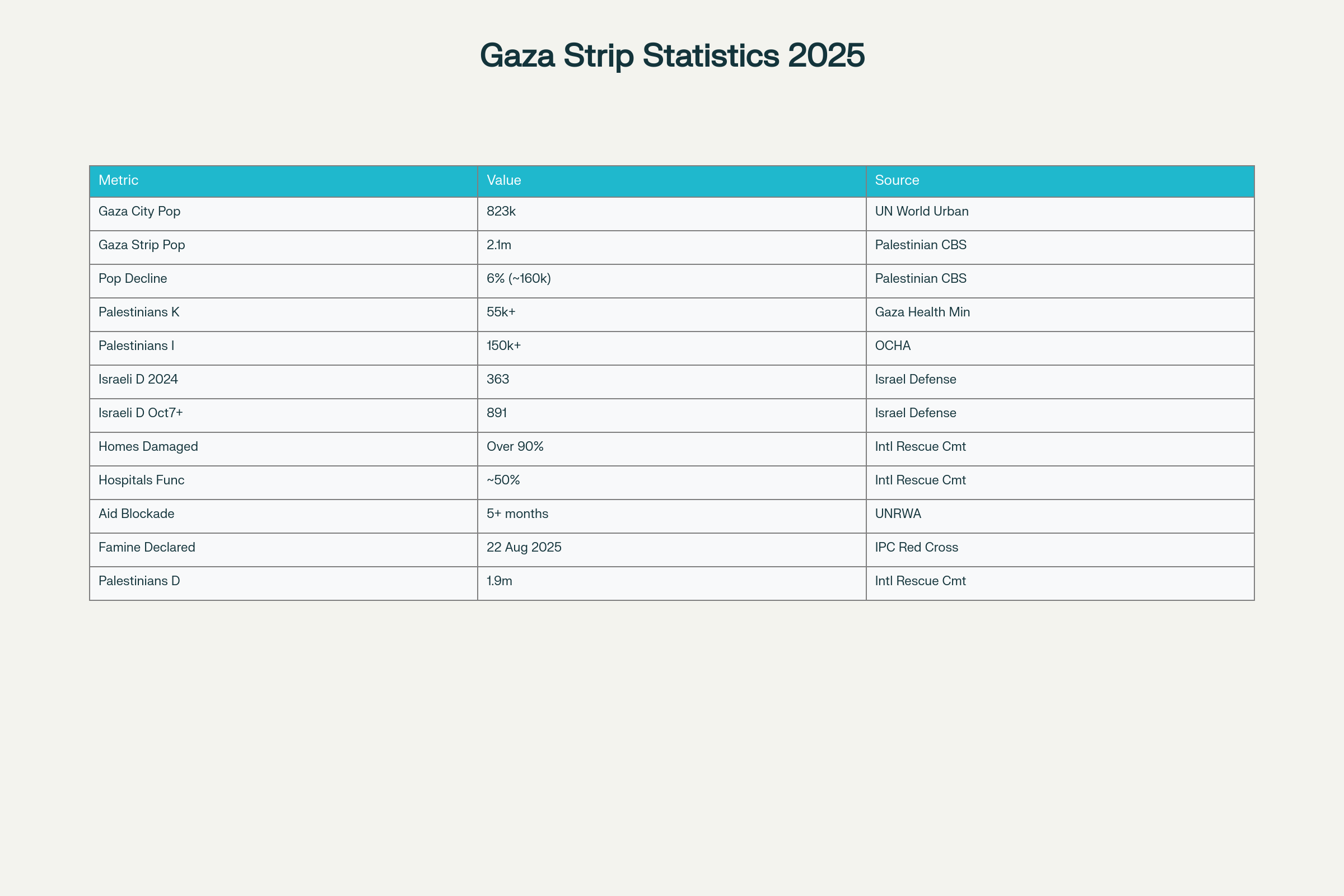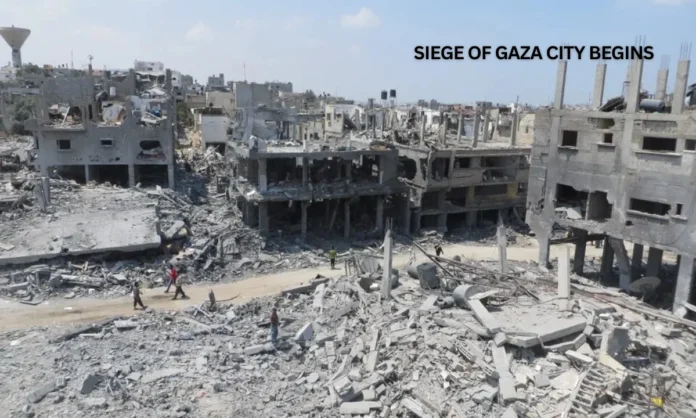Key Highlights:
- Gaza City, once home to 823,000 residents and serving as Hamas’ de facto capital since 2007, now faces an imminent Israeli military offensive targeting remaining militant strongholds
- The Palestinian Central Bureau of Statistics confirms Gaza’s population has declined by 6% since the war began, with over 55,000 Palestinians killed and 150,000 wounded according to official health ministry data
- Israel plans to deploy 60,000 additional reserve troops for the Gaza City operation, with officials warning residents they have approximately two months to evacuate before the October 7 symbolic deadline
Initial Context: From Regional Hub to War Zone
Gaza City stands at the epicenter of one of the Middle East’s most devastating conflicts, transforming from a thriving Palestinian cultural and administrative center into a war-torn landscape of destruction and desperation. The coastal metropolis, which housed 823,407 residents as of 2025 according to UN World Urbanization Prospects, served as Hamas’ political headquarters since the militant group seized control of the Gaza Strip in 2007. Today, Gaza City faces an imminent Israeli military assault designed to eliminate remaining Hamas strongholds and establish Israeli control over what Prime Minister Benjamin Netanyahu describes as one of the organization’s last bastions.
The pending Gaza City offensive represents a culmination of nearly two years of warfare that began with Hamas’ October 7, 2023 attack on Israel. Israeli forces have already positioned themselves at the city’s periphery, with Brigadier General Effie Defrin confirming that preliminary operations have commenced. The Israel Defense Forces plan to evacuate the densely populated area before launching what military officials anticipate will be a months-long urban warfare campaign through Gaza City’s extensive tunnel networks and residential districts.
This Gaza City operation occurs against the backdrop of unprecedented humanitarian devastation across the broader Gaza Strip. The Palestinian Central Bureau of Statistics reports that Gaza’s overall population has declined by 6% since the conflict began, falling from approximately 2.24 million to 2.1 million residents. The Gaza Health Ministry confirms that over 55,000 Palestinians have been killed and more than 150,000 wounded since October 2023, while the International Rescue Committee estimates that over 90% of homes throughout Gaza have been damaged or destroyed.
Military Preparations and Strategic Objectives for Gaza City Control
Israeli military planners have designed the Gaza City offensive as a comprehensive urban warfare operation requiring unprecedented troop deployments and extended service commitments. The operation necessitates calling up 60,000 additional reserve soldiers while extending service periods for another 20,000 personnel currently deployed in Gaza and other conflict zones. This massive mobilization reflects the complexity Israeli commanders anticipate in securing Gaza City, which encompasses approximately 45 square kilometers and contains extensive underground infrastructure developed by Hamas over nearly two decades of control.
Israeli military officials acknowledge that Hamas forces in Gaza City have had nearly two years to prepare defensive positions and expand tunnel networks throughout the urban landscape. An Israeli military source told CNN that Hamas’ underground system, which Israel refers to as “the metro,” proves far more complex than initially anticipated, featuring strategic command hubs, tactical movement tunnels, and surprise attack positions. The extended preparation time has allowed Hamas militants to establish what military analysts describe as a sophisticated urban insurgency network within Gaza City’s residential and commercial districts.
The Gaza City assault timeline extends Israeli military operations that have already claimed significant casualties on both sides. Israel Defense Forces data confirms that 891 Israeli military personnel have died since October 7, 2023, with 363 fatalities occurring in 2024 alone. The June 2025 period marked Israel’s deadliest month of the year, with 20 soldiers killed in Gaza operations, including 15 who died during battles in Khan Younis. These Gaza City casualty figures highlight the sustained intensity of urban combat operations that Israeli forces expect to encounter throughout the upcoming offensive.
Military experts anticipate that the Gaza City operation will require several months to complete, with Israeli forces systematically clearing buildings, destroying tunnel networks, and establishing control over civilian infrastructure. The symbolic October 7 deadline that Israeli officials have reportedly set for beginning major Gaza City evacuations underscores the political significance attached to completing the operation by the second anniversary of Hamas’ initial attack.
Humanitarian Crisis Intensifies as Gaza City Residents Face Evacuation
The humanitarian situation in Gaza City has deteriorated to catastrophic levels as residents confront the dual pressures of ongoing warfare and impending forced displacement. The Integrated Food Security Phase Classification declared famine conditions in the Gaza Governorate, which includes Gaza City, on August 22, 2025, affecting the entire remaining population. The International Committee of the Red Cross reports treating over 3,400 weapon-wounded patients since May 2025, exceeding the total for all of 2024, while UNRWA confirms it has been prevented from bringing humanitarian aid into Gaza for over five months.
Gaza City residents describe living conditions that have collapsed into lawlessness and desperation following the destruction of Hamas’ governing apparatus. Majdi Abu Hamdi, a 40-year-old father of four, reports that dust from explosions permeates the few remaining standing buildings, while blown-out windows make breathing difficult. The breakdown of municipal services has left residents without regular access to clean water, with Palestinians reporting they can use bathroom facilities only every three days due to food scarcity and extreme poverty. Criminal gangs reportedly control informal banking systems, charging commission rates up to 50% for cash withdrawals.
The collapse of Gaza City’s medical infrastructure has left residents without access to hospitals, pharmacies, or basic healthcare services. Nearly half of Gaza’s 36 hospitals remain only partially functional, operating without adequate staff, medical supplies, or equipment to treat both conflict-related injuries and routine health problems. The International Rescue Committee maintains over 5 tons of medical supplies ready for delivery to Gaza City, but Israel’s blockade has prevented humanitarian organizations from accessing the area for months.
Children constitute a particularly vulnerable population within Gaza City, representing 47% of Gaza’s remaining 2.1 million residents according to Palestinian Central Bureau of Statistics data. Families report widespread malnutrition, with children, pregnant women, and elderly residents being treated for severe nutritional deficiencies in the limited medical facilities that remain operational. The combination of food shortages, destroyed schools, and constant displacement has created what humanitarian organizations describe as a generation of Palestinian children facing long-term physical and psychological trauma.
Palestinian Resistance and Hamas’ Evolving Structure in Gaza City
Hamas maintains operational capabilities within Gaza City despite nearly two years of sustained Israeli military pressure and the destruction of its visible governmental infrastructure. The organization demonstrated its continued presence during January 2025 ceasefire negotiations, when armed Hamas members emerged in full uniform at Gaza City’s public squares to oversee hostage releases. These carefully choreographed ceremonies served as deliberate displays of organizational resilience and territorial control, designed to project strength despite extensive military losses.
The militant group has adapted its Gaza City operations to function as an underground insurgency rather than a conventional governing authority. Hamas has established specialized units such as “Al Rade’a” (The Deterring), which emerged in August 2025 to combat criminal gangs and maintain internal security within areas under Hamas influence. This subgroup claimed responsibility for executing alleged collaborators and criminals throughout Gaza, including six individuals in Khan Younis, demonstrating Hamas’ continued capacity for internal enforcement and territorial control.
Military analyst Alex Plitsas of the Atlantic Council explains that Hamas functions as a hybrid organization combining elected governmental responsibilities with insurgent military tactics. The group has conducted recruiting operations throughout the conflict to replace casualties and maintain operational strength, though precise numbers of remaining Hamas fighters in Gaza City remain classified by Israeli military intelligence. Israeli military officials acknowledge that Hamas forces have used the extended preparation period to develop sophisticated defensive positions throughout Gaza City’s urban landscape.
The complexity of Hamas’ Gaza City network reflects the organization’s nearly two-decade evolution from a purely militant group to a governing entity with deep community roots. Unlike conventional military forces, Hamas operates through decentralized cells that can function independently when command structures are disrupted. This organizational flexibility has enabled the group to maintain resistance capabilities despite losing most of its visible governmental infrastructure, creating significant challenges for Israeli forces planning to establish long-term control over Gaza City.
Closing Assessment: Gaza City’s Uncertain Future
The impending Israeli assault on Gaza City represents a decisive phase in a conflict that has already fundamentally transformed Palestinian society and Israeli military strategy. The operation’s success depends not only on tactical military objectives but also on Israel’s ability to establish sustainable governance structures in a city where two decades of Hamas rule created deep institutional and social connections with the local population. The massive troop deployment required for Gaza City operations reflects Israeli recognition that urban warfare against an embedded insurgency presents extraordinary challenges even for one of the world’s most advanced militaries.
The humanitarian cost of the Gaza City offensive will likely exceed even the devastating toll already documented throughout the broader Gaza Strip. With 2.1 million Palestinians facing famine conditions and critical infrastructure destroyed, the forced displacement of Gaza City’s remaining population risks creating a humanitarian catastrophe that could destabilize regional stability for generations. The symbolic timing of the October 7 deadline underscores how military objectives have become intertwined with political narratives that may complicate post-conflict resolution efforts.
International observers and humanitarian organizations continue to warn that the Gaza City operation could constitute collective punishment of Palestinian civilians, while Israeli officials maintain that eliminating Hamas’ remaining strongholds represents a necessary security objective. The outcome of this Gaza City assault will likely determine not only the immediate future of Palestinian governance in Gaza but also the broader trajectory of Israeli-Palestinian relations in the coming decades.

Official statistics on Gaza City and Gaza Strip population, casualties, and humanitarian crisis as of 2025


